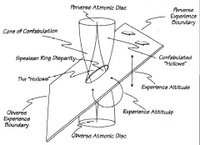April 16, 2006
soft metamedia?
 April 7th I heard Lev Manovich talk at Pratt. I am a big fan of Manovich’s written work, and the Language of New Media was instrumental in my analysis of tagging.
April 7th I heard Lev Manovich talk at Pratt. I am a big fan of Manovich’s written work, and the Language of New Media was instrumental in my analysis of tagging.
Friday night Manovich showed us ideas in progress, and bravely admitted that they were not completely formed. He talked about describing the evolution of media in evolutionary terms. As in, the next logical progression after getting all our media digitized (i.e., simulating physical processes w/in the digital environment) is the breeding and hybridization of the media. He is claiming that some of what we are now seeing in ‘moving graphics’ or ‘design cinema’ is actually a new form of media, distinct from what came before it. And he is interested in identifying the trunks and branches of this media evolution.
Plaid Itsu was a film he used as an example of a completely new form. Whereas multimedia was the assembly of multiple forms of media adjacent to each other, metamedia is the combination of these forms into a new unified whole. He pointed out the live action photography, combined with traditional design aesthetics, combined with graphics, etc etc. Not sure I bought it, but it was an interesting assertion.
The best question from the audience alluded to a longstanding disconnect between media and communication theorists. Manovich is looking exclusively at the end product of the media being created, and not examining the cultural and social conditions that lead to its creation. There may be mileage from this rarefied approach, as some patterns are discernible, but it does seem to be lacking the depth to explain the creative dynamics and underlying motivations.
After the talk, I began to this relate his line of reasoning to Arthur Young’s theory of process:
The Theory of Evolutionary Process as a Unifying Paradigm
Theory of Process Poster (too bad this isn’t really visible online)
Which I first became exposed to through the work of the Meru Foundation:
letter matrix
It seems to me that the evolutionary forces that Manovich is documenting conform to the trans-disciplinary evolutionary process that Young articulated. For what its worth, the hybridization of media that Manovich claims we failed to predict, was foretold back in this book on the MIT Media Lab, published in 1988.
 Filed by jonah at 11:34 pm under aesthetics,epistemology,fire
Filed by jonah at 11:34 pm under aesthetics,epistemology,fire
No Comments

 Today I presented last year’s
Today I presented last year’s  4 Comments
4 Comments